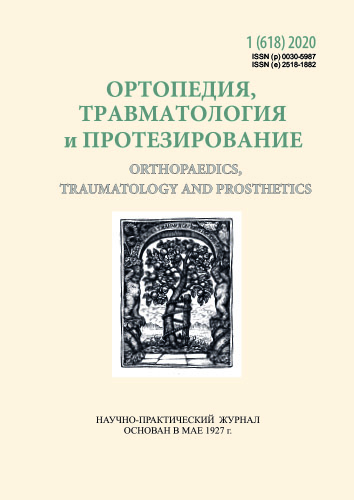Results of application fragility index asd-fi for spinal surgery in elderly patients
DOI:
https://doi.org/10.15674/0030-5987202019-14Keywords:
frailty index, spinal surgery, comorbidities, complicationsAbstract
Identification of potential risks of complications before and after spinal surgery is one of the main task and challenge for the surgeon. That is why, modern health care system needs instruments for stratification of possible surgical complication.
Objective: to assess results of Adult Spinal Deformity Fraility Index application in elderly patients after spinal surgery.
Methods: we performed retrospective analyses of 38 cases in patients who underwent surgical intervention on the spine. Adult Spinal Deformity Fraility Index was assessed on the basis of diagnostic work-up, indication for surgery and existing comorbidities. If Adult Spinal Deformity Fraility Index was less then 0.3 patient was not frail, 0.3–0.5 meant frailty and more then 0.5 confirms severe frailty. In every group of patients American Society of Aneastesiologists scale and Oswestry Disability Index were estimated.
Results: there were 27 complication in 12 patients (31.5 %) with relatively higher Adult Spinal Deformity Fraility Index score (over 0.4). Preoperative patient optimisation and appropriate surgical technique selection allowed to decrease number of complications in postoperative period. We found satisfactory correlation between Adult Spinal Deformity Fraility Index and Oswestry Disability Index score.
Conclusions: Adult Spinal Deformity Fraility Index assessment allows to reveal group of high risk patients and to correct their condition to prevent potential complications. It is possible to reveal patients with contraindication for spinal surgery.
References
- Rodríguez-Mañas, L., Féart, C., Mann, G., Viña, J., Chatterji, S., Chodzko-Zajko, W., … & Vega, E. (2012). Searching for an operational definition of frailty: A Delphi method based consensus statement. The frailty operative definition-consensus conference project. The Journals of Gerontology: Series A, 68(1), 62-67. https://doi.org/10.1093/gerona/gls119
- Mak, P. H., Campbell, R. C., & Irwin, M. G. (2002). The ASA physical status classification: Inter-observer consistency. Anaesthesia and Intensive Care, 30(5), 633-640. https://doi.org/10.1177/0310057x0203000516
- Bagshaw, S. M., & McDermid, R. C. (2013). The role of frailty in outcomes from critical illness. Current Opinion in Critical Care, 19(5), 496-503. https://doi.org/10.1097/mcc.0b013e328364d570
- Velanovich, V., Antoine, H., Swartz, A., Peters, D., & Rubinfeld, I. (2013). Accumulating deficits model of frailty and postoperative mortality and morbidity: Its application to a national database. Journal of Surgical Research, 183(1), 104-110. https://doi.org/10.1016/j.jss.2013.01.021
- Fairbank, J. C., & Pynsent, P. B. (2000). The Oswestry disability index. Spine, 25(22), 2940-2953. https://doi.org/10.1097/00007632-200011150-00017
- Mukaka, M. M. (2012). A guide to appropriate use of correlation coefficient in medical research. Malawi Medical Journal, 24(3), 69-71
- Miller, E. K., Neuman, B. J., Jain, A., Daniels, A. H., Ailon, T., Sciubba, D. M., … & Ames, C. P. (2017). An assessment of frailty as a tool for risk stratification in adult spinal deformity surgery. Neurosurgical Focus, 43(6), E3. https://doi.org/10.3171/2017.10.focus17472
- Silva, F. E., & Lenke, L. G. (2010). Adult degenerative scoliosis: Evaluation and management. Neurosurgical Focus, 28(3), E1. https://doi.org/10.3171/2010.1.focus09271
- Schwab, F., Blondel, B., Chay, E., Demakakos, J., Lenke, L., Tropiano, P., … & Lafage, V. (2014). The comprehensive anatomical spinal osteotomy classification. Neurosurgery, 74(1), 112-120. https://doi.org/10.1227/neu.0000000000000182o
- Kelly, M. P., Lurie, J. D., Yanik, E. L., Shaffrey, C. I., Baldus, C. R., Boachie-Adjei, O., … & Bridwell, K. H. (2019). Operative versus nonoperative treatment for adult symptomatic lumbar scoliosis. The Journal of Bone and Joint Surgery, 101(4), 338-352. https://doi.org/10.2106/jbjs.18.00483
- Fried, L. P., Tangen, C. M., Walston, J., Newman, A. B., Hirsch, C., Gottdiener, J., … & McBurnie, M. A. (2001). Frailty in older adults: Evidence for a phenotype. The Journals of Gerontology Series A: Biological Sciences and Medical Sciences, 56(3), M146-M157. https://doi.org/10.1093/gerona/56.3.m146
- Miller, E. K., Lenke, L. G., Neuman, B. J., Sciubba, D. M., Kebaish, K. M., Smith, J. S., … & Ames, C. P. (2018). External validation of the adult spinal deformity (ASD) frailty index (ASD-FI) in the Scoli-RISK-1 patient database. SPINE, 43(20), 1426-1431. https://doi.org/10.1097/brs.0000000000002717
- Reid, D. B., Daniels, A. H., Ailon, T., Miller, E., Sciubba, D. M., Smith, J. S., … & Ames, C. P. (2018). Frailty and health-related quality of life improvement following adult spinal deformity surgery. World Neurosurgery, 112, e548-e554. https://doi.org/10.1016/j.wneu.2018.01.079
- Yagi, M., Michikawa, T., Hosogane, N., Fujita, N., Okada, E., Suzuki, S., … & Watanabe, K. (2019). Treatment for frailty does not improve complication rates in corrective surgery for adult spinal deformity. SPINE, 44(10), 723-731. https://doi.org/10.1097/brs.0000000000002929
Downloads
How to Cite
Issue
Section
License
Copyright (c) 2020 Dmytro Petrenko, Dmytro Demchenko, Oleksandr Chekryzhev, Myhailo Kutz, Andriy Mezentsev

This work is licensed under a Creative Commons Attribution 4.0 International License.
The authors retain the right of authorship of their manuscript and pass the journal the right of the first publication of this article, which automatically become available from the date of publication under the terms of Creative Commons Attribution License, which allows others to freely distribute the published manuscript with mandatory linking to authors of the original research and the first publication of this one in this journal.
Authors have the right to enter into a separate supplemental agreement on the additional non-exclusive distribution of manuscript in the form in which it was published by the journal (i.e. to put work in electronic storage of an institution or publish as a part of the book) while maintaining the reference to the first publication of the manuscript in this journal.
The editorial policy of the journal allows authors and encourages manuscript accommodation online (i.e. in storage of an institution or on the personal websites) as before submission of the manuscript to the editorial office, and during its editorial processing because it contributes to productive scientific discussion and positively affects the efficiency and dynamics of the published manuscript citation (see The Effect of Open Access).














